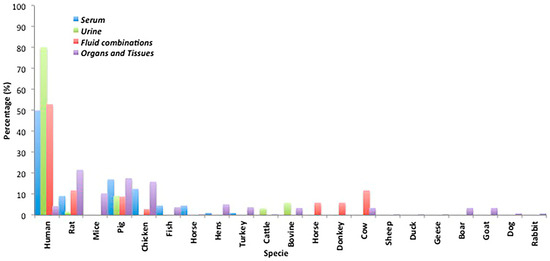Leading Opinions (Closed)
A topical collection in Toxins (ISSN 2072-6651).
Viewed by 94457Editors
Interests: venom molecular evolution; protein structure prediction; protein-ligand interactions; molecular dynamics simulations; pharmacophore modeling; computational ligand docking
Interests: bacterial toxins; GTPases; signal transduction; toxins and carcinogenesis
Interests: mycotoxins; fungal metabolites; antimicrobial; anticancer; antinflammatory; antioxidant
Special Issues, Collections and Topics in MDPI journals
Topical Collection Information
Dear Colleagues,
Toxins are the poisonous products of organisms, such as plants, animals, or a wide variety of microorganisms. They are small molecules, peptides, or proteins, respectively. Despite their chemical variety, all toxins are biological weapons that allow the producing organism to hunt for prey or to defend itself.
In this Topical Collection of Toxins we are presenting “Leading Opinions” in:
1. Animal venoms
Venomous animals produce their venom secretion in specialized cells. The venom is delivered to a target animal through evocation of a wound. Once inside the target animal the venom disrupts endophysiological or biochemical processes in order to facilitate feeding, defense, or competition.
2. Bacterial toxins
Pathogenic bacteria produce a cocktail of protein toxins, which support their survival in the host organism. The toxins trigger the behavior of eukaryotic cells by diverse, but mostly highly-specific, mechanisms. Reprogramming of host cells includes inhibition of the immune cells, as well as a weakening of the barrier function of epithelia.
The growing knowledge about cellular receptors, uptake mechanisms, and molecular action of bacterial toxins open new fields for inhibition of the bacterial weapons and, on the other hand, allows the targeted use of these highly efficient enzymes for cell biological and therapeutic applications.
3. Mycotoxins
Mycotoxins are small molecules corresponding to secondary metabolites produced by pathogenic molds that infect plants and crops. It is now clear that these toxins play a critical role during host colonization. Unfortunately, in addition to cause massive damages in crops, mycotoxins, due to their high stability and prevalence in the food chain, cause also collateral victims: animals and humans ingesting contaminated foods. To limit the economical and health impacts of mycotoxins, we need to better understand the role played by mycotoxins during plant infection, to perform comparative studies of the effects of mycotoxins in plants and animals and to identify mechanisms able to confer resistance to mycotoxin effects.
Advancement in the understanding of how toxins are administered and act, as well as how they can be targeted, is happening at fast pace and in a wide range of scientific disciplines. Leading scientists will be invited to present current developments and ideas to the “Leading Opinions” Topical Collection of Toxins.
Prof. Dr. Holger Scheib
Prof. Dr. Gudula Schmidt
Dr. Marc Maresca
Collection Editors
Manuscript Submission Information
Manuscripts should be submitted online at www.mdpi.com by registering and logging in to this website. Once you are registered, click here to go to the submission form. Manuscripts can be submitted until the deadline. All submissions that pass pre-check are peer-reviewed. Accepted papers will be published continuously in the journal (as soon as accepted) and will be listed together on the collection website. Research articles, review articles as well as short communications are invited. For planned papers, a title and short abstract (about 100 words) can be sent to the Editorial Office for announcement on this website.
Submitted manuscripts should not have been published previously, nor be under consideration for publication elsewhere (except conference proceedings papers). All manuscripts are thoroughly refereed through a double-blind peer-review process. A guide for authors and other relevant information for submission of manuscripts is available on the Instructions for Authors page. Toxins is an international peer-reviewed open access monthly journal published by MDPI.
Please visit the Instructions for Authors page before submitting a manuscript. The Article Processing Charge (APC) for publication in this open access journal is 2700 CHF (Swiss Francs). Submitted papers should be well formatted and use good English. Authors may use MDPI's English editing service prior to publication or during author revisions.














